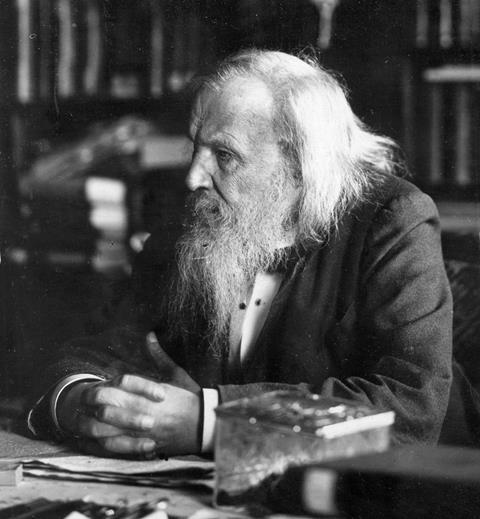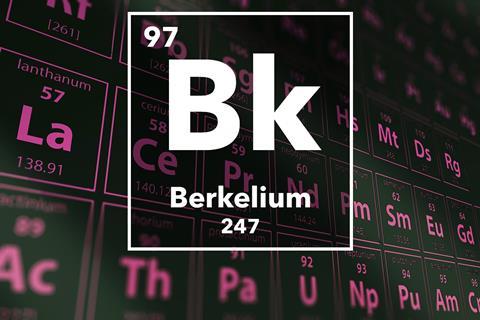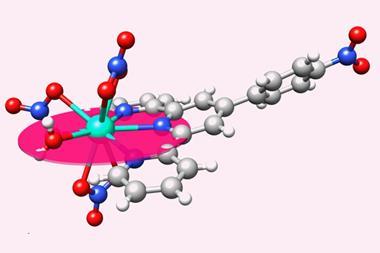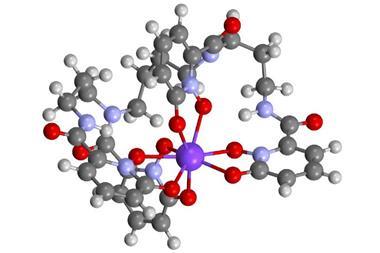Meera Senthilingam
This week, no prizes for guessing where this element's name comes from. Eric Scerri.
Eric Scerri
Element 97 in the periodic table is one of only two elements named after a university, namely the University of California at Berkeley. The other such element is number 110 called darmstadtium after the University of Darmstadt in Germany. The university and the city of Berkeley were in turn named after the Anglo-Irish philosopher, Bishop George 'Barkeley'. The pronunciation changed from Barkeley to Berkeley when the name crossed the Atlantic ocean in 1869, the year that the city and university were both founded. Incidentally this was the same year in which Dimitri Mendeleev published the first mature periodic system and began to predict the existence of new elements.

But let me get back to berkelium. It was the fifth element in the periodic table after the last naturally occurring element, uranium, to be artificially synthesised. Berkelium was first made some 60 years ago by Stan Thomson, Al Ghiroso and Glen Seaborg by bombarding the isotope americium-241 with alpha particles. The half-life of the first isotope of berkelium to be produced in this way was a healthy 4.5 hours. Subsequently discovered isotopes have included berkelium-249 with a half-life of as much as 314 days.
One of the discoverers, Glen Seaborg, was a member of various teams that synthesised a total of 10 elements over a period of many years. His success led to a proposal that he should have an element named after him. But the official governing body, the International Union of Pure and Applied Chemistry, refused to accept this, on the basis that no living scientist had ever been honoured in this way, although actually the element fermium was proposed when the Italian physicist Enrico Fermi was still living and was indeed accepted.

Finally after much campaigning by chemists around the world, IUPAC relented and element 106 was duly named seaborgium while he was still alive. This led to an amusing situation whereby people could try to send letters or postcards to Seaborg by using nothing but a sequence of symbols of various elements in the following order. First of all one could write Sg for element 106 or Seaborg's name. The second line consisted of Bk for this week's element 97 or the University at which Seaborg worked. The third line was Cf for element 98, or californium, or the state in which the university stands. Finally, if writing from abroad, the correspondent could add Am for element 95, or americium, or the country of America to complete the address.
To the credit of several postal systems around the world a handful of people did indeed succeed in getting letters and messages of congratulations to Seaborg in this cryptic fashion.
Many compounds of element 97, berkelium, have been prepared. Unlike the extremely short half-lives possessed by the superheavy elements like 117 and 118 that have been in the news recently, experiments on berkelium are relatively easy to perform and its chemistry has been studied in some detail.
The existence of weighable amounts of berkelium-249 have made it possible to determine some of its properties using macroscopic quantities. Although the pure element has not yet been isolated, it is predicted to be a silvery metal that would easily oxidise in air at high temperatures and would be soluble in dilute mineral acids.
X-ray diffraction techniques have been used to identify various berkelium compounds such as berkelium dioxide (BkO2), berkelium fluoride (BkF3), berkelium oxychloride (BkOCl), and berkelium trioxide (BkO3). The oxidation states seen so far are +3 and +4 in accordance to its position below terbium in the periodic table.

In 1962 visible amounts of berkelium chloride were isolated, weighing 3 billionth of a gram. This was the first time that visible amounts of a pure berkelium compound had been produced.
Like other actinides, berkelium accumulates in skeletal tissue and is therefore highly toxic to humans. The element has not found any uses yet outside of basic research and plays no known biological role. Nevertheless its discovery was an important step towards the synthesis of the superheavy elements and has served to test theories of nuclear physics as well as showing that the predictions of the periodic table are fulfilled well beyond the elements for which it was originally devised.
Meera Senthilingam
Sp playing a pivotal role in fundamental chemistry and physics, while also testing the chemical knowledge of postal services worldwide. That was scientist and author Eric Scerri from UCLA with the discovery of Berkelium. Now next week, an element that requires a magic touch – as long as you don't get too close.
Peter Wothers
The next exciting thing about caesium, is that my love is not unrequited, it responds to my touch. Strictly speaking, it's the warmth from the hand that melts it, given that its melting point is only 28.4°C. So just holding its container converts the crystalline solid into liquid gold. Liquid metals are always fascinating - everyone loves mercury; just imagine playing with liquid gold!
But here's the snag that adds to my fascination with this metal - it has a rather fiery temper. In fact, you can't actually touch the metal itself since it spontaneously bursts into flames in the presence of air and reacts explosively with water. Awkward indeed. My caesium is sealed inside a glass tube under an atmosphere of the chemically inert gas argon. So to play with it, you have to hold the glass tube, knowing that if you accidentally crushed it, or dropped it, all hell would break loose.
Meera Senthilingam
And as well as a possible adrenalin rush, join Cambridge University's Peter Wothers for more exciting facts about the liquid gold element that is caesium in next week's Chemistry in its element. Until then thank you for listening, I'm Meera Senthilingam.













No comments yet